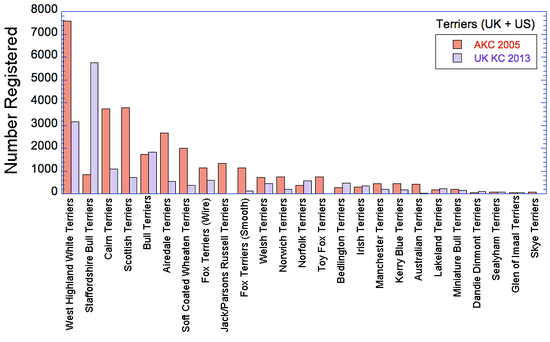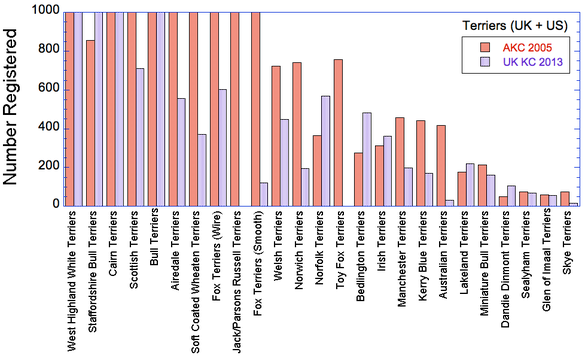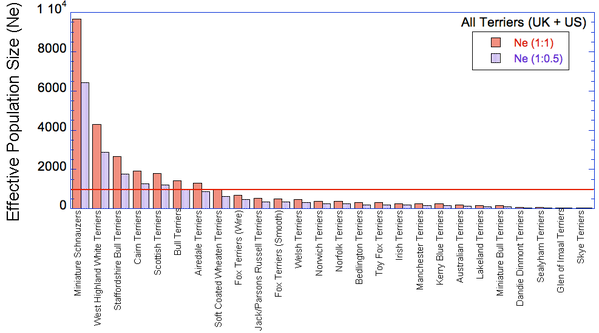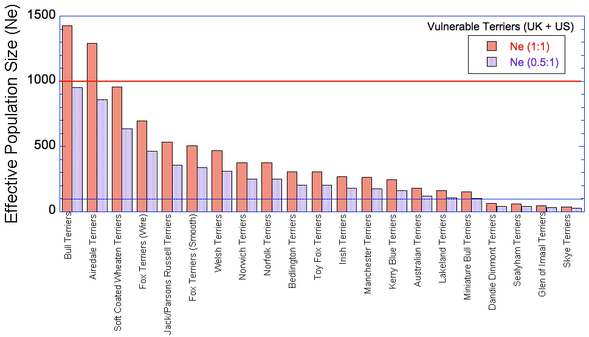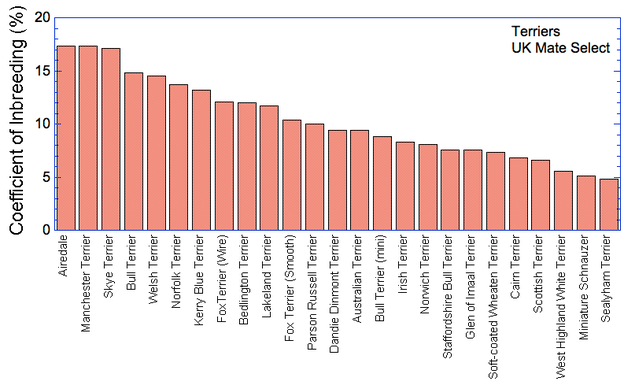I have discussed here the UK Kennel Club's list of vulnerable native breeds, which is based on registration records. You should read that before continuing here, so you understand what I'm doing.
One problem with their list is that it considers only the populations of dogs in the English and Irish KC's records. It might be the case that the global population of a breed is sufficient to breed sustainably for the forseeable future. To explore this, I have have combined the most recent registration statistics of the UK Kennel Club (from 2014), and the last records made available by the AKC, which are from 2005. (Shame on you, AKC. We need those data!) This still leaves out the registrations in all the other countries, but for now this is the best we can do. (I don't have the Irish KC records that were included in determining vulnerable status by the UK KC.)
Below is the same graph as above, but scaled to a maximum of 1,000 registrations on the y-axis.
Below are two graphs. The top one is for all terrier breeds in the database. A red horizontal line identifies Ne = 1,000, the recommended minimum population size for long-tern sustainability from the 100/1,000 rule (formerly 50/500, as discussed in that previous article). There are two values of Ne for each breed. One assumes that the ratio of males to females in the population is 1:1 (red bars) and the other assumes that only half as many males as females are bred (blue bars). In most breeds, fewer males are used than females, but the ratio can vary widely from breed to breed, and many won't be this extreme.
It is important to note that these data for Ne are almost surely overestimates of the true value because they are based only on the number of males and females that are bred. Other things also affect Ne, such as the degree of inbreeding, which is assumed here to be 0% and is undoubtably 15% or more for most of these breeds (see below). It wouldn't be unreasonable to consider these estimated effective population sizes to be double or more than the actual values.
So, if we take Ne = 1,000 as the minimum sustainable population size for these breeds, then there are clearly many breeds in trouble. Although the Ne for the largest breeds (e.g., Mini Schnauzers, Westies) would seem more than sufficient, genetic disorders are already common in both so there's not much room for optimism that they are safely out of danger because of large population size.
In the lower graph, I have replotted the same data with a maximum Ne of 1,500 to display the smallest breeds more appropriately, and I have added a horizontal line (blue) marking Ne = 100, considered the minimum number of animals needed to found a breed without incurring immediate inbreeding. There are a fair number of breeds that reach the Ne = 100 mark, but remember again that these are surely very optimistic estimates of Ne. If the ratio of breeding males to females is one to one, only two breeds (Bull Terriers and Airedales) exceed the Ne = 1,000 mark, and none make the mark for the lower ratio of males to females.
In the graph above, the effective population sizes of Dandie Dinmonts, Sealyhams, Glen of Imaal Terriers, and Skyes are far below the minimum population size. These breeds have been down there for many generations already and they might hang in there for many more, but if we're going to manage genetic disorders and keep them around for a while, we should be working on a plan now.
So the prudent question to ask now is about the level of inbreeding in these breeds. Of course, AKC does not provide the data necessary to do these calculations, but the UK KC does offer Mate Select. Their statistics are based on the dogs registered in the previous year (not an average of the entire breed), and their database only goes as far back as their digital records (sometime in the 1960s; why this is bad) and would also not include ancestor information for imported dogs past the previous 3 generations. So in fact, these data really aren't all that useful except as an indication of the rosiest possible picture, because all of these issues will result in an underestimation of the degree of inbreeding. That said, here is a graph of those data.
So what we have are a bunch of breeds with a level of inbreeding AT LEAST as high as what you would get from mating first cousins. In fact, most of these breeds are (optimistically) as inbred as the offspring of a half-sib cross. I noted that these figures would be underestimates; do we have any better estimates to compare them with?
I just analyzed a very incomplete pedigree database for Westies - missing data, misspelled names, the works, so again the COI would be an underestimate, but the data did go back to the turn of the century. From that, the average COI of the current population of dogs (in the world) is about 15%, and I am certain that is a significant underestimate. By comparison, Westies in Mate Select smell like roses with a COI of only 5.6%, so adjust your perception of the data for the other breeds accordingly. I would not be at all surprised to find the true COI for many terrier breeds to be in excess of 25%, but right now we don't have the data to know. Note that a COI of 25% means that 25% of the genes in the dog are homozygous. There aren't enough DNA tests to even come close to identifying all potential deleterious alleles in a dog, and in any case if the consequence of testing is to eliminate dogs from the breeding pool, the inbreeding situation will only get worse.
I have already looked at the historical registration figures for the UK Kennel club, and quite apart from the single-year figures examined here, there are some signs of even more potential trouble. Large fluctuations in population size are very damaging to the gene pool of a breed, as I explained here, and a few of the UK breed populations have just passed or are right in the middle of some major cycles. Westies, Staffordshire Bull Terriers, and Border Terriers have had spectacular increases in population size followed by crashes in the last decade (those graphs are here), so the registration numbers we used for these breeds in our calculations of Ne above were far higher than the more stable population sizes before the boom. The crash of the Westies population is pretty much complete, but the Border Terrier is still on the way down, so there might be some opportunity there to prevent less popular lines or founder genes from being lost if only the data were available to do the appropriate analyses. If there is anyone out there in Border Terriers, it would be worth looking into the situation and mitigate now before the damage is completely done. The Staffie is a little further along, but intervention is possible and better late than never.
Sadly, there is much more to the terrier situation than was revealed in a simple list of "vulnerable" breeds. There are many breeds for which I suspect the breeders are quite unaware of how dire the situation is. New genetic disorders pop up regularly, litter sizes get smaller, puppy mortality increases, and dogs die before their time, but these problems are not generally viewed as symptomatic of a growing hole in the bottom of the boat. Instead, breeders diligently dig in to try to solve the problems, not realizing that most of what they are doing - more testing, ever more careful selection of breeding stock, keeping only the very best puppies to breed - is just making things worse. The thing that is important for breeders to realize is that you can't breed your way out of inadequate genetic diversity within a closed gene pool. Unfortunately, we need both education and leadership if we're going to turn this boat around. ICB is working on education, but I don't see any kennel club stepping up to the plate to coordinate what will need to be a coordinated, global effort to save these breeds.
Don't think there is trouble just in terriers. The inside poop on the other groups is coming soon...
Learn more about the genetics of dogs in ICB's Online Courses.
Visit our Facebook Groups
ICB Institute of Canine Biology
...the latest canine news and research
ICB Breeding for the Future
...the science of animal breeding
